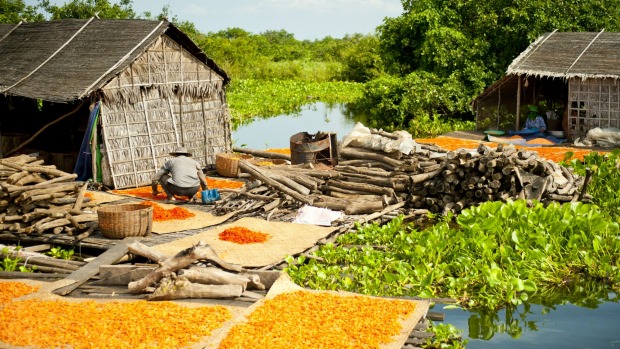
Our eco-friendly motor boat cruises into the first floating village on Cambodia's great lake, part of the mighty Mekong river system, a scene of unimaginable beauty.
Children are swimming in the sparkling blue-green water. Women paddle their boats, laden with bananas, flowers, fresh vegetables, rice or other produce from floating house to floating house. One family is gathered on a floating verandah, flicking the fish they have caught in nets they are hauling up into the holding pens suspended beneath their floating house.
Our Cambodian guide, Hoeum, tells us there are 173 floating villages on Tonle Sap Lake, the aquatic heart beating in the centre of Cambodia.
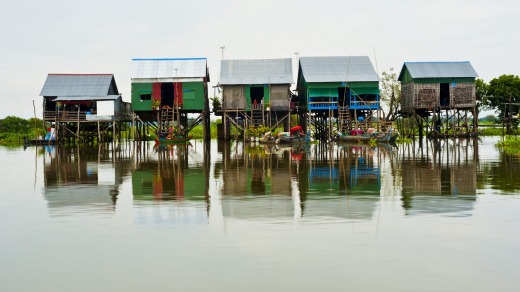
This is one of the most magnificent stretches of water on the planet, a UNESCO-designated biosphere, a fish-breeding reserve, a bird-watcher's paradise and the largest freshwater lake in South-East Asia.
In his illustrated talk the previous afternoon — aboard our cruise ship, the Aqua Mekong — Hoeum had told us that Tonle Sap Lake is of immense importance to the nation's wellbeing.
It has a unique life cycle, he explains: expanding and shrinking dramatically each year according to the wet or dry seasons.
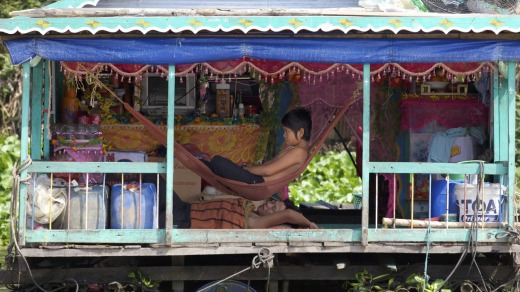
We are visiting at the end of the wet season when the lake is at its greatest: 16,000 square kilometres and up to nine metres deep (compared to 2700 square metres and one metre deep at the end of the dry season).
Fishing is banned during the wet season because the lake is a prime breeding ground. But a few weeks ago, the fishermen had returned to the edges of the swollen lake, bringing their floating houses to re-establish their floating villages.
Most of these itinerant villagers are Vietnamese, not Cambodian. Why, we ask?
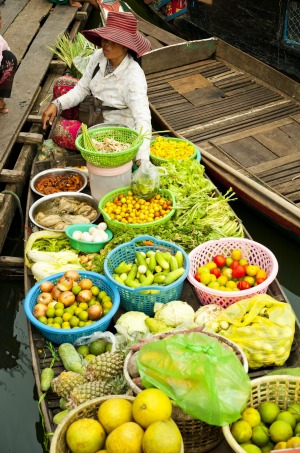
"Cambodian people very lazy," Hoeum says with a smile. "They not greedy. They live for today. The Vietnamese people work harder, think ahead."
Our first stop is the floating school. Obviously it has no playground, but the primary school children, who are on their morning break when we arrive, wave and beckon us to see their school.
According to our Aqua Mekong guides, we are the first Westerners to have visited this village. The children show surprise, the adults feign distain. Either way, we are the new kids in town.
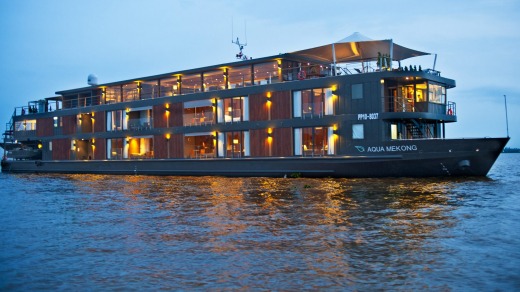
We board the floating platform that holds the school. The two teachers addressing their pupils in two of the three classrooms don't seem to mind us peeking through the tiny wooden windows and watching: one class is doing maths, the other art. The third class is taking a mid-morning break since there is only enough room for 20 or 30 children to be on the surrounding deck at any one time.
Since this is morning, these are the younger children, who attend school from 7am to 11am. Their older siblings replace them in the afternoon. Though their language at home is Vietnamese, their lessons are in Cambodian.
When they are ready to attend middle school, they attend a more permanent structure on concrete posts, which we see later in the day in a neighbouring floating village.
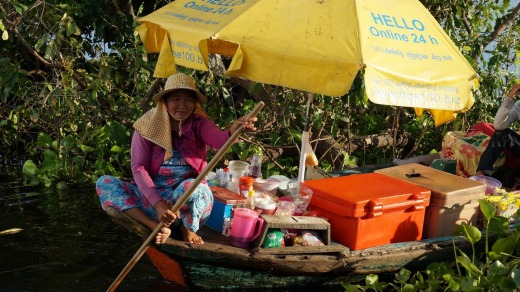
High-school students are sent to a government boarding school in one of the larger towns downstream, where the Tonle Sap shrinks again to the size of a river.
After half an hour, we reboard our motor launch and spend a few minutes looking at the floating church, moored next door. These Vietnamese nomads are overwhelmingly Catholic, hence the priest inside.
The photo opportunities are endless as our launch glides through the village. There's the floating fuel station. Is that the floating supermarket? And look at this floating clothes shop.
For a few minutes we follow a small canoe, with four children in it. One, a smiling girl aged around eight or nine, is doing all the paddling as they make their way home from school for lunch.
The next floating village, 15 minutes away, is something of a rarity. Most of the people here are Cambodian, hence the floating Buddhist temple that is our first stop.
There are only five monks, three of them teenagers. When we board, take off our shoes, and sit on the mats they have provided, they perform a series of welcome chants.
The Americans in our party decide we should reply with a popular song the monks should know — which is why I suddenly find myself singing along to You Are My Sunshine on a floating temple on Cambodia's biggest lake.
We leave the floating temple and explore the rest of the floating village. At one floating house, we're invited aboard. I'm feeling too awkward to invade a house without sufficient invitation so I stay put, observing the fish drying on the washing line, ready for market.
But, then, a bizarre photo opportunity: A floating saleswoman paddles up selling a range of groceries, a sun umbrella over her canoe advertising a 24-hour internet access site.
Next stop is one of the floating ice factories on the lake. By now it is afternoon, and the ice-making is over. The team aboard the platform is preparing for tomorrow's ice production. The noise of the machinery drowns out much of the explanation of how water is pumped up from the lake, sloshed into gigantic ice-cube holders, and frozen (somehow) in tropical temperatures. Without this ice, the lake's fish would never reach its international markets.
The following day we visit one of South-East Asia's greatest bird sanctuaries. In the dry season, Prek Toal — one of three biospheres on Tonle Sap Lake — is an ornithologist's heaven. But today it is pouring and visibility is down to 10 metres, making the 5.30am bird-watching wake up call a waste of time. Next stop? Angkor Wat. Do the wonders never cease?
www.aquaexpeditions.com
Vietnam Airlines flies daily from Ho Chi Minh City, with connections to and from Siem Reap or Phnom Penh, with transfers to the Aqua Mekong. If you are joining or departing in Phnom Penh, Vietnam Airlines operates three flights a day between Ho Chi Minh City and Phnom Penh. See www.vietnamairlines.com.
Aqua Expeditions operates three-, four- and seven-night adventures between Ho Chi Minh City and Siem Reap (or vice versa). Cruises include transfers to and from the vessel and meeting points in Ho Chi Minh City and Siem Reap, beverages and entrance fees en route. Phone 1800 243 152 or see www.aquaexpeditions.com.